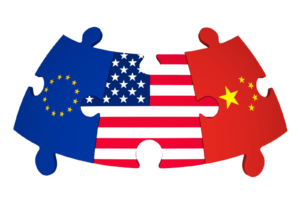IP Licensing
Intellectual Property (“IP”) licensing opens doors for businesses to spread their wings, expand their revenue streams, and introduce new products to the market. This licensing is the granting of a right to use IP while retaining ownership of it. Through licensing, companies can venture into new territories not otherwise possible. Though the benefits of a good licensing agreement can be substantial, failing to have one in place before bringing a product to market can carry significant liability, particularly when those new products advance upon the ideas and creations of others.
Navigating Liability: The Apple Case Study
Just recently, Apple was found liable by the International Trade Commission for patent infringement surrounding the blood oxygen technology in its Apple Watches. Versions of its watches with this technology not only faced an import ban, but watches were also removed from store shelves. Rather than attempting to duplicate their own version of this patented technology, Apple could have licensed the technology from patent owner Masimo, and both companies could have benefited from the collaboration. That is of course, if Masimo had been willing to license its technology in the first place, though given the benefits of licensing discussed below, Masimo would have been wise to do so.
Diverse Applications of Intellectual Property Licensing
The potential applications for IP licensing are broad. These types of agreements license trademarks, trade secrets, design patents, copyrights, and more. Patent licenses are seen in the production of technological marvels, healthcare advancements, software, and even chemical products. Trademark licenses on the other hand, bring a brand’s magic to all sorts of goods and services. Copyright licenses cover everything from art to music to the worldwide distribution of movies.
With an IP license, companies can develop strong working relationships with experts in new fields. They can quicken the pace of a product launch and beat competitors to market by capitalizing on another company’s existing distribution channels. They can enter new regions and expand worldwide. They can even generate new streams of revenue by placing their brand on new products altogether, and reaching customers they never thought they could.
Crafting a Robust Licensing Agreement
These licenses are, plain and simple, contracts. They delineate the rights and responsibilities between the licensor (the owner of the intellectual property) and the licensee (the entity seeking to utilize it). In a licensing agreement, a licensor that owns the IP provides their creation to another on specific terms. These contracts spell out the scope of the rights licensed, and the proportion of revenue or royalties that are to be shared.
Legality and Your Licensing Agreement
Though this post focuses on the business benefits of IP licensing, it is important to remember that these agreements are legal contracts. To ensure a smooth collaboration and protect your interests, your licensing agreement should address key legal considerations. Here’s a brief explanation of some important terms:
- Infringement Clauses: These clauses outline the steps to be taken if a third party infringes upon the licensed intellectual property. They may specify how damages are handled and how each party is responsible for upholding the rights.
- Indemnification: This clause determines which party (licensor or licensee) is financially liable if there’s a legal claim of infringement. A well-crafted indemnification clause protects you from unforeseen liabilities.
- Dispute Resolution: This section outlines the process for resolving disagreements arising from the licensing agreement. It may specify arbitration or litigation in a particular jurisdiction.
Crafting a robust license agreement demands meticulous attention to detail and open communication between the parties. Negotiation often becomes the cornerstone as both sides strive to strike a mutually beneficial arrangement. From cost structures to territorial delineations, the agreement must encapsulate diverse considerations, including exclusivity, and conveyed rights. In the realm of trademarks, these licenses also should include quality control provisions that ensure the final products protect and advance the high standards of the licensed brand, meet consumer expectations, and protect a company’s good will.
Conclusion: Embracing Collaborative Solutions
IP licensing can be a transformative strategy for businesses seeking to unlock new opportunities and propel growth. By fostering collaboration, innovation, and strategic alliances, IP licensing agreements enable companies to navigate complex market landscapes and capitalize on emerging trends. A well drafted IP license agreement can help your businesses reach its full potential, drive substantial and sustainable growth, and foster long-term success.

























